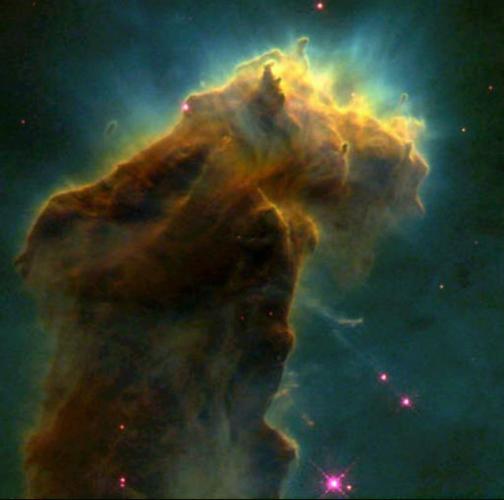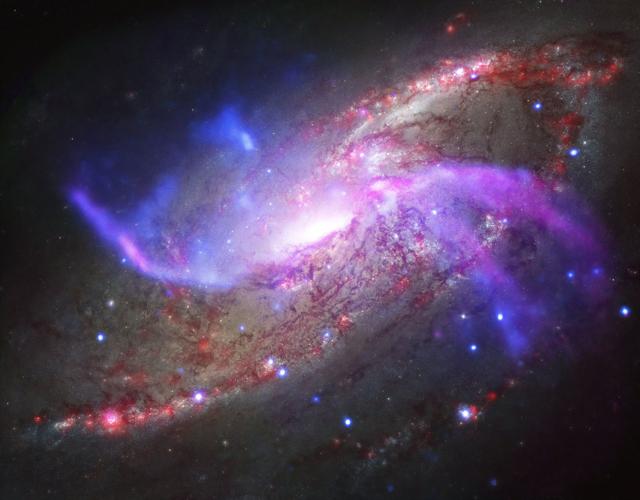When the Hubble Space Telescope blasted off from Earth on board the space shuttle Discovery 30 years ago this month, scientists from the University of Arizona were already hard at work on a new set of eyes for the orbiting observatory.
Three years before, a team led by astronomy professor Rodger Thompson was tapped by NASA to build the next generation of instruments for Hubble.
Their mission: To design a camera that could see through clouds of cosmic dust and capture waves of light so stretched by time and distance that they were no longer visible to the human eye.
The team’s groundbreaking creation, the Near Infrared Camera and Multi-Object Spectrometer, or NICMOS, would be added to Hubble in 1997, expanding the legacy of discovery for one of mankind’s most famous scientific tools.
“We changed infrared astronomy,” Thompson said, but Hubble has achieved something even greater.
“It has completely changed the way we look at the universe,” he said.
From flawed to “fabulous”
Thompson was a 40-year-old astronomer and professor at the UA when he first got involved in the development of a new space-based telescope in 1984.
With an orbit outside the distortion of Earth’s atmosphere, the new platform would be able to capture extremely sharp images with substantially less background light than ground-based observatories.
And with the help of NASA’s burgeoning space shuttle program, the telescope could be regularly serviced and improved while in orbit.
Thompson said that has been one of Hubble’s most unique and valuable attributes — the ability to add new instruments or repair and upgrade existing ones.
“The requirement was that it would last five years. The goal was that it would last 10 years,” Thompson said.
Yet there it is, still going strong three decades later.
In the summer of 1990, though, Hubble looked like it might turn out to be an embarrassing and expensive failure.
About two months after it was put into orbit, researchers discovered a major flaw in a mirror inside the telescope — a mirror thankfully not made at the UA, Thompson said.
He was at a conference in the Netherlands when he got the bad news in a 2 a.m. phone call.
“That was the most down moment I could remember,” he said.
It took several years to identify the exact nature of the flaw and design a way to compensate for it. An $86 million repair mission by the space shuttle Endeavour in 1993 corrected the telescope’s blurred vision.
“That’s when Hubble became the fabulous instrument it is now,” Thompson said.
A new innovation added in orbit
He was there at Kennedy Space Center in Florida on April 24, 1990, as the space shuttle Discovery blasted off with Hubble on board.
But the stakes were even higher for Thompson when he returned to Cape Canaveral seven years later.
Thompson said the first attempt to launch NICMOS was aborted with four minutes left in the countdown due to an internal power failure on board Discovery. They tried again about a week later, on Feb. 11, 1997.
“We were just crossing our fingers,” he said.
As soon as the shuttle safely cleared the tower, Thompson headed for the airport to catch a flight to Houston so he could monitor Discovery’s orbital capture of Hubble and the installation of their instrument from Mission Control.
The UA’s Steward Observatory won the contract to build the near-infrared instrument over a competing team from the University of Hawaii.
Thompson said his team worked on the project for three years before it even knew whether it would get to build the cutting-edge camera — or even if it could.
To make the instrument work, they had to pioneer a new array that would dramatically increase the resolution of near-infrared images. Thompson said they essentially took what was a one-pixel camera and turned it into a 65,000-pixel camera.
“When we were chosen (by NASA), they were taking a very big chance on us, because the arrays didn’t exist then,” he said.
As principal investigator, Thompson oversaw every aspect of the project from the design and construction to the packaging of NICMOS for launch.
The government had designated Hubble and its components as “national assets,” which meant a level of security rivaling that for Air Force One, he said.
Early on, when it looked like they might have to transport NICMOS to Cape Canaveral by ship instead of cargo plane, he recalled being summoned to a meeting at the Pentagon to discuss how many Marines would be needed to guard the instrument as it passed through the Panama Canal.
Armed guards were posted outside the building at the Kennedy Space Center where NICMOS was kept before launch.
“I had to have exactly the right badge or they would shoot me,” Thompson said, only half-joking.
Training the astronauts
He even helped train the astronauts to install and connect the instrument, which is roughly the size and shape of a large upright freezer and weighs about 700 pounds.
He said he worked with shuttle crew members at NASA’s Goddard Space Flight Center in Maryland and at Johnson Space Center in Houston, where astronauts practiced servicing Hubble in a giant tank of water to simulate working in low gravity.
Thompson never went into the tank himself. “I’m not a trained diver,” he said.
When the time came for the real thing, Thompson was “on console” at Mission Control, watching the astronauts through the cameras on their helmets and in the open payload bay of Discovery.
It was a “nerve-wracking” 15 minutes, he said, but the installation went flawlessly.
Surprising new discoveries waiting in the deep
An “aliveness test” soon confirmed that NICMOS was fully connected and ready to go, though scientists would have to wait about two weeks for the instrument to reach its operational temperature of about minus 200 degrees Fahrenheit before they could start using it.
The first thing they looked at was a “rather unspectacular” star cluster that had already been mapped by Hubble, so they could check for any distortions in their new instrument.
Soon they were piercing through once-impenetrable dust clouds to gaze at a star that had just been “born.” Around it, they saw nine other, smaller stars spun off during the birthing process.
“It was the first time we’d ever seen anything like that,” Thompson said.
Even more surprises awaited them when they trained the near-infrared camera on vast, very dark patches of space known as “Hubble deep fields.”
The data collected by NICMOS helped astronomers identify some of the most distant objects ever observed by man — galaxies more than 13 billion light-years away, captured when the universe was only a fraction of its current age.
Thompson compared it to a letter, mailed from a distant land, that describes the world as it was when it was written, not as it is now.
“In our case, (the letter) took 13 billion years to reach us,” he said. “We got to see things as they were billions of years ago.”
Hubble’s new infrared eyes also helped astronomer Brian Schmidt, one of Thompson’s former undergraduate students at the UA, make a startling discovery that would eventually win him a share of the 2011 Nobel Prize for Physics. Using NICMOS images of exploding stars, Schmidt determined that the expansion of the universe was speeding up, not slowing down as previously thought.
Arizona to equip the next space telescope
NICMOS initially operated from March 1997 until January 1999, when it exhausted its nitrogen coolant sooner than expected and had to shut down.
The instrument was revived in March 2002, after the crew of the space shuttle Columbia installed a new cooling system that kept the infrared camera running until 2008.
Since then, it has largely been replaced by a new wide-field camera installed on Hubble in 2009, though scientists have been able to mine new discoveries from old NICMOS images using improved data analysis techniques.
Now the UA is playing a central role in the next generation of infrared space telescopes.
Arizona astronomer and professor Marcia Rieke has been named principal investigator for the main, near-infrared camera on the James Webb Space Telescope, which is scheduled for launch in 2021.
She also served as Thompson’s deputy principal investigator on NICMOS.
Another group, led by Rieke’s husband and fellow UA astronomy professor George Rieke, is developing a mid-infrared-wavelength camera for the new telescope.
Unlike Hubble, the JWST, as it is known, is not designed to be retrieved and serviced. Instead, it will orbit the sun about 940,000 miles from Earth, four times farther away than the moon and well beyond the current reach of astronaut mechanics.
A legacy etched in the sky
No one knows for sure how much longer the Hubble telescope might last, but its legacy is already etched in the sky.
Thompson said the 30-year-old orbiting observatory has “sparked more interest in science and in understanding the universe than any other mission.”
First, the Apollo program brought us images of the Earth from a distance. Then the Voyager spacecraft showed us our place in the solar system. Now there is Hubble, expanding our horizons to the very edges of what we know to exist.
“It has brought the universe to people to see so they can feel a part of it,” said Thompson, who celebrates his own milestone this year: 50 years at the UA. “It has made us citizens of the universe.”






